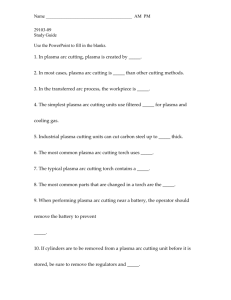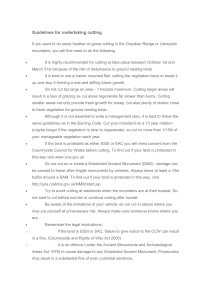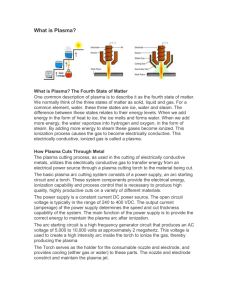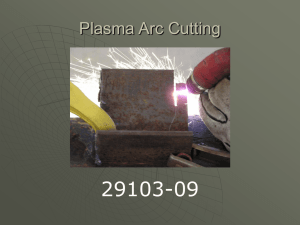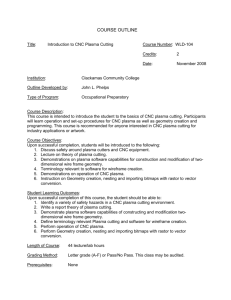A Brief Overview of Plasma Cutting Arc Constriction
advertisement
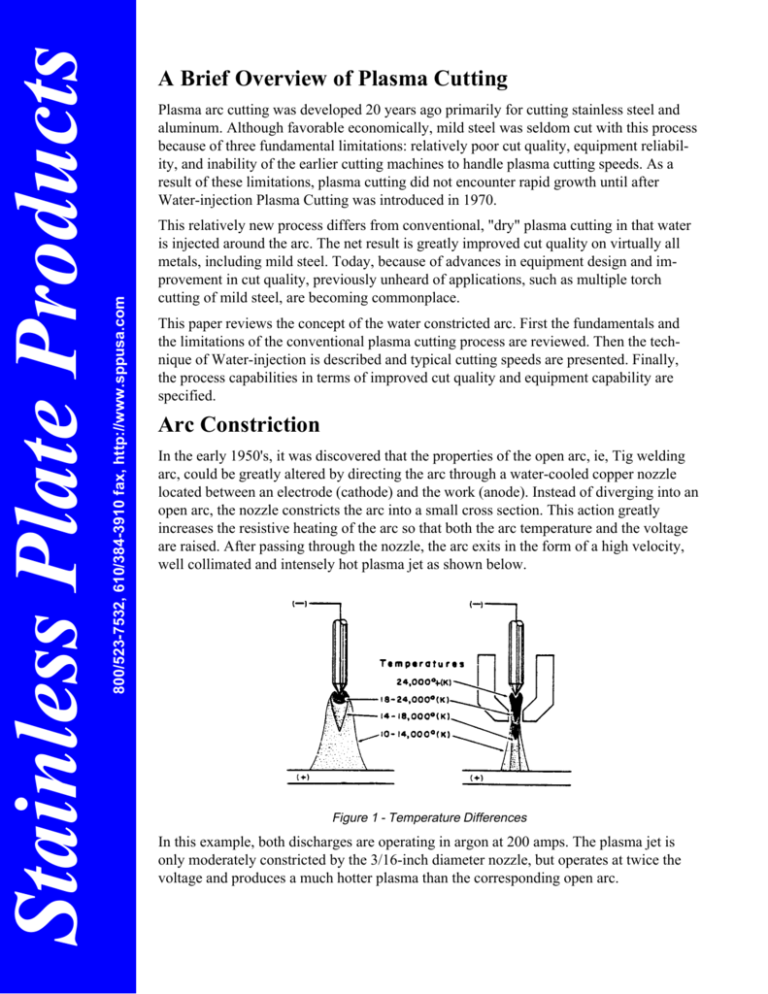
Plasma arc cutting was developed 20 years ago primarily for cutting stainless steel and aluminum. Although favorable economically, mild steel was seldom cut with this process because of three fundamental limitations: relatively poor cut quality, equipment reliability, and inability of the earlier cutting machines to handle plasma cutting speeds. As a result of these limitations, plasma cutting did not encounter rapid growth until after Water-injection Plasma Cutting was introduced in 1970. 800/523-7532, 610/384-3910 fax, http://www.sppusa.com Stainless Plate Products A Brief Overview of Plasma Cutting This relatively new process differs from conventional, "dry" plasma cutting in that water is injected around the arc. The net result is greatly improved cut quality on virtually all metals, including mild steel. Today, because of advances in equipment design and improvement in cut quality, previously unheard of applications, such as multiple torch cutting of mild steel, are becoming commonplace. This paper reviews the concept of the water constricted arc. First the fundamentals and the limitations of the conventional plasma cutting process are reviewed. Then the technique of Water-injection is described and typical cutting speeds are presented. Finally, the process capabilities in terms of improved cut quality and equipment capability are specified. Arc Constriction In the early 1950's, it was discovered that the properties of the open arc, ie, Tig welding arc, could be greatly altered by directing the arc through a water-cooled copper nozzle located between an electrode (cathode) and the work (anode). Instead of diverging into an open arc, the nozzle constricts the arc into a small cross section. This action greatly increases the resistive heating of the arc so that both the arc temperature and the voltage are raised. After passing through the nozzle, the arc exits in the form of a high velocity, well collimated and intensely hot plasma jet as shown below. Figure 1 - Temperature Differences In this example, both discharges are operating in argon at 200 amps. The plasma jet is only moderately constricted by the 3/16-inch diameter nozzle, but operates at twice the voltage and produces a much hotter plasma than the corresponding open arc. 800/523-7532, 610/384-3910 fax, http://www.sppusa.com Stainless Plate Products A plasma jet can either be operated in the transferred mode, where the power supply is connected between the electrode and the workpiece, or in the nontransferred mode where the power supply is connected between the electrode and the nozzle.Both modes of operation are illustrated in Figure 2. Although a stream of hot plasma emerges from the nozzle in both modes of operation, the transferred mode is always used in plasma cutting because the usable heat input is most efficiently applied when the arc is in electrical contact with the workpiece. Figure 2 - Two Basic Types of Constricted Arcs The characteristics of the plasma jet can be altered greatly by changing the gas type, gas flowrate, arc current, and nozzle size. For example, if low gas flow rates are used, the plasma jet will be a highly concentrated heat source ideal for welding. Conversely, if the gas flowrate is increased sufficiently the plasma jet will cut through the workpiece; the velocity of the plasma jet will be high enough to blast away the molten metal created by the plasma arc. In this paper only the plasma cutting process--the use of a plasma arc developed under conditions of high gas flow and high current--will be discussed. The plasma cutting arc is considerably hotter than the example described above in Figure 1. Greater temperatures are possible because the high gas flow forms a realtively cool boundary layer of unionized gas inside the nozzle bore, thereby allowing a higher degree of arc constriction. The thickness of this boundary layer can be further increased by swirling the cutting gas: The swirling action forces the cool, unionized gas to move radially outward and form a thicker boundary layer. Most mechanized plasma cutting torches swirl the cutting gas to attain maximum arc constriction. Conventional Plasma Arc Cutting The plasma jet that is generated by conventional "dry" arc constriction techniques can be used to sever any metal at relatively high cutting speeds. The thickness of plate can range from 1/8 inch to a maximum thickness depending on both the current capacity of the torch and the physical properties of the metal. A heavy duty mechanized torch with a current capacity of 1000 amps can cut through 5 inch thick stainless steel and 6 inch thick aluminum. However, in most industrial applications the plate thickness seldom exceeds 1-1/2 inch. In this thickness range, conventional plasma cuts are usually beveled and have a rounded top edge. 800/523-7532, 610/384-3910 fax, http://www.sppusa.com Stainless Plate Products Beveled cuts are a result of an imbalance in heat input into the cut face. As shown in Figure 3, a positive cut angle will result if the heat input into the top of the cut exceeds the heat input into the bottom. One obvious approach to reduce this heat imbalance is to apply the arc constriction principle described in Figure 1: increased arc constriction will cause the temperature profile of the plasma jet to become more uniform and, correspondingly, the cut will become more square. Unfortunately, the conventional nozzle is limited by the tendency to establish two arcs in series---electrode to nozzle, and nozzle to work. This phenomenon is known as "double arcing" and can damage both the electrode and nozzle. Figure 3 - Positive Cut Angle Conventional plasma cutting can be cumbersome to apply if the user is cutting a wide variety of metals and plate thickness. For example, if the conventional plasma process is used to cut stainless steel, mild steel and aluminum, it will be necessary to have three different cutting gases on hand if optimum cut quality is to be obtained. This requirement not only complicates the process, but necessitates stocking expensive cutting gases such as 65% argon - 35% hydrogen. Process Refinements Several modifications of the conventional process were introduced in the 1960's to improve cut quality in the 1/8 inch to 1-1/2 inch thickness range. It is important to understand the advantages and limitations of these various process refinements because these methods compete to a limited extent with Water-injection Plasma Cutting. "Dual Flow" Plasma Cutting The Dual Flow technique, developed around 1965, is a slight modification of the conventional plasma cutting process. Essentially it incorporates the same features as conventional plasma cutting except that a secondary shield gas is added around the nozzle (Figure 4). Usually the cutting gas is nitrogen and the secondary shielding gas is selected according to the metal to be cut. Secondary shield gases typically used are: mild steel-either air or oxygen; stainless steel--CO2; aluminum--argon--hydrogen mixture. Cutting speeds are slightly better than with conventional cutting on mild steel; however, cut The major advantage of this approach is that the nozzle can be recessed within a ceramic shield gas cup as shown in Figure 4, thereby protecting the nozzle from double arcing. If no shield gas were present, the ceramic shield gas cup could deteriorate because of the high radiative heat load produced by the plasma jet. 800/523-7532, 610/384-3910 fax, http://www.sppusa.com Stainless Plate Products quality is inadequate for many applications. Cutting speed and quality on stainless steel and aluminium are essentially the same as with the conventional process. Figure 4 - Dual Flow Plasma Cutting Air cutting was introduced in the early 1960's for cutting mild steel. The oxygen in the air provides additional energy from the exothermic reaction with molten steel. This additional energy increases cutting speeds by about 25%. Although the process can be used to cut stainless steel and aluminum, the cut surface will be heavily oxidized and unacceptable for many applications. Special electrodes, made of zirconium or hafnium, must be used since tungsten will erode in seconds if the cutting gas contains oxygen. Even with these special electrodes, the service life is must less than what can be achieved with the conventional plasma cutting process. Although air cutting is no longer used in the United States, it is gaining renewed interest in Eastern Europe, England and Japan. The major supplier of this equipment is Mansfeld of East Germany. Several ship yards in Japan are known to be using Mansfeld air cutting equipment; however, the electrode life averages around 1.7 hours which is low by most standards. A Soviet designed air plasma cutting system has also gained some recognition in Western Europe and Japan. Both the performance and design are very similar to the Mansfeld system. "Oxygen Injection" Plasma Cutting This process refinement circumvented the electrode life problem associated with air cutting by using nitrogen as the cutting gas and introducing oxygen downstream in the nozzle bore as shown in Figure 5. 800/523-7532, 610/384-3910 fax, http://www.sppusa.com Stainless Plate Products Figure 5 - Oxygen Plasma Cutting This process is used exclusively on mild steel and increases cutting speed by about 25% if the optimum gas mixture is used (80% N2 - 20% O2). The major disadvantages are lack of cut squareness, short nozzle life, and limited versatility (mild steel only). Although this process is still being used at some locations, it has been almost entirely displaced by Water-injection cutting. "Water Shield" Plasma Cutting Water Shield plasma cutting is similar to Dual Flow except that water is substituted for the shield gas. Cut appearance and nozzle life are improved because of the cooling effect provided by the water. Cut squareness, cutting speed and dross tendency are not measurably improved because the water does not provide additional arc constriction. Water-injection Plasma Cutting Earlier it was stated that the key to achieving improved cut quality is through increasing arc constriction. In the Water-injection Plasma Cutting process, water is radially injected into the arc in a uniform manner as shown in Figure 6. The radial impingement of the water around the arc provides a higher degree of arc constriction than can be achieved by conventional means. Arc temperatures in this region are estimated to approach 50,000 degrees K, or roughly nine times the surface temperature of the sun. The net result is improved cut squareness and increased cutting speeds. This radial water-injection technique was developed and patented by Hypertherm, Incorporated. Another approach to constricting the arc with water is to develop a swirling vortex of water around the arc. This technique does not perform as well as radial injection because the degree of arc constriction is limited by the high swirl velocities needed to produce a stable water vortex: the centrifugal force created by the high swirl velocity tends to flatten the annular film of water against the inner bore of the nozzle. 800/523-7532, 610/384-3910 fax, http://www.sppusa.com Stainless Plate Products Figure 6 - Water Injection Plasma Cutting Unlike the conventional processes described earlier, optimum cut quality is obtained on all metals with just one cutting gas---nitrogen. This single gas requirement makes the process more economical and easier to use. Physically, nitrogen is ideal because of its superior ability to transfer heat from the arc to the workpiece. As illustrated in the equation below, the heat energy, Eh, absorbed by nitrogen when it dissociates, is relinquished when it recombines at the workpiece. N2 + Eh = N + N Despite the extremely high temperatures generated at the point where the water impinges the arc, less than 10% of the water is vaporized. The remaining 90% of the water exits from the nozzle in the form of a conical spray which cools the top surface of the workpiece. This additional cooling prevents the formation of oxides on the cut surface. Little water is evaporated at the arc because an insulating boundary layer of steam forms between the plasma and the injected water. This steam boundary layer, usually referred to as a "Lindenfrost Layer", is the same principle that allows a drop of water to dance around on a hot skillet rather than immediately vaporizing. Nozzle life is greatly increased with the Water-injection technique because the steam boundary layer insulates the nozzle from the intense heat of the arc, and the water cools the nozzle at the point of maximum arc constriction. The protection afforded by the water-steam boundary layer also allows a unique design innovation: the entire lower portion of the nozzle can be ceramic. Consequently, double arcing from the nozzle touching the workpiece--the major cause of nozzle destruction--is virtually eliminated. An important property of these cuts is that when viewed in the direction of the cut, as shown in Figure 6, the right side of the kerf is square and the left side of the kerf is slightly beveled. This feature is not caused by Water-injection; rather, it results from the cutting gas which is swirled in a clockwise direction, causing more of the arc energy to be expended on the right side of the kerf. This same asymmetry exists in conventional "dry" cutting when the cutting gas is, swirled; however, the difference in cut angle is not so evident because of excessive bevel and rounding of the top edge. In shape cutting appli- 800/523-7532, 610/384-3910 fax, http://www.sppusa.com Stainless Plate Products cations, this means that the direction of travel must be selected to produce a square cut on the production part. Figure 7 - Direction of Cut On the annular shaped part shown in Figure 7, the outside cut is made in a clockwise direction so the saved piece is always on the right side of the kerf. Similarly, the inside cut must be made in a counterclockwise direction to maintain a square edge on the inside of the part. In most applications, like the one shown in Figure 7, the beveled side of the cut is discarded when evaluating squareness. Counterclockwise swirl rings are available for applications, such as mirror image cutting, where the high quality side must be on the left. Summary Water-injection plasma cutting is capable of cutting virtually all metals ranging from 1/8 inch to 3 inches thick. In this thickness range, Water-injection plasma cutting offers some distinct advantages over both conventional plasma cutting and the process variations that are available. These advantages are: relatively square cuts at high cutting speeds; smooth, clean cut face; dross free cuts on most materials including mild steel; increased nozzle life since the ceramic bottom piece insulates the nozzle, thereby preventing double arcing; use of one cutting gas, nitrogen, for all metals. The cut angle on the high quality side will usually be within two degrees of square and will seldom require machining or finishing. The most widespread application of Water-injection Plasma Cutting has been multiple torch cutting of mild steel. The high cutting speeds achievable with Water-injection plasma cutting, together with the capabilities of N/C cutting machines, enable the user to greatly increase his productivity. Cutting costs are typically 1/2 to 1/4 that of oxy-fuel cutting. The conventional "dry" cutting mode allows the cutting plate in the 3 to 6 inch thickness range. In this mode of operation the injection water is used for nozzle cooling only; arc constriction is achieved purely by the nozzle. A gas mixture os 65% argon and 35% hydrogen is used instead of nitrogen because it develops a deep penetrating plasma jet necessary for cutting heavy plate. This capability is ideal for steel service center applications and nuclear vessel fabricators. J.A. Hogan and J.B. Lewis, "Plasma Processes of Cutting and Welding". (Project Report by Bethlehem Steel Corporation in cooperation with U.S. Maritime Administration 1976). Adapted from "20 Years To Practical Plasma", Hypertherm. 800/523-7532, 610/384-3910 fax, http://www.sppusa.com Stainless Plate Products References
